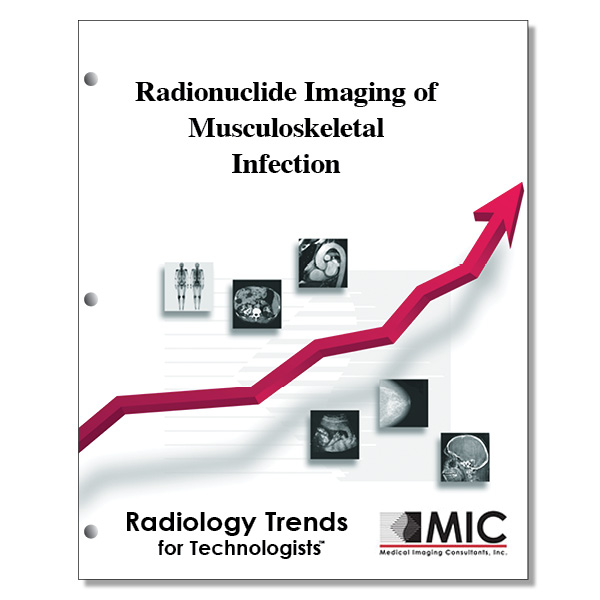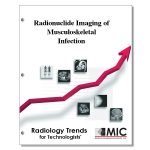

Radionuclide Imaging of Musculoskeletal Infection
A look at the various radiopharmaceuticals used in the diagnostic workup of patients suspected of having musculoskeletal infection.
Course ID: Q00492 Category: Radiology Trends for Technologists Modalities: CT, Nuclear Medicine1.5 |
Satisfaction Guarantee |
$24.00
- Targeted CE
- Outline
- Objectives
Targeted CE per ARRT’s Discipline, Category, and Subcategory classification for enrollments starting after February 14, 2023:
[Note: Discipline-specific Targeted CE credits may be less than the total Category A credits approved for this course.]
Computed Tomography: 0.25
Procedures: 0.25
Head, Spine, and Musculoskeletal: 0.25
Magnetic Resonance Imaging: 0.25
Procedures: 0.25
Musculoskeletal: 0.25
Nuclear Medicine Technology: 1.50
Procedures: 1.50
Other Imaging Procedures: 1.50
Radiography: 0.25
Procedures: 0.25
Extremity Procedures: 0.25
Registered Radiologist Assistant: 0.75
Procedures: 0.75
Musculoskeletal and Endocrine Sections: 0.75
Sonography: 0.25
Procedures: 0.25
Superficial Structures and Other Sonographic Procedures: 0.25
Outline
- Introduction
- Morphologic Imaging
- Radiography
- MRI
- CT and Ultrasonography
- Radionuclide Imaging
- Bone Scintigraphy
- 67Ga Scintigraphy
- Labeled Leukocyte Scintigraphy
- 111In-Biotin
- Radiolabeled Antiobiotics
- Radiolabeled Antimicrobial Peptides
- 18F-FTG
- 18F-FDG-Labeled Leukocytes
- 68Ga-Citrate
- 124I-Fialuridine
- Indications
- Spondylodiskitis
- Diabetic Pedal Osteomyelitis
- Prosthetic Joint Infection
- Conclusion
Objectives
Upon completion of this course, students will:
- identify the systemic risk factors for acute osteomyelitis
- be familiar with the morphological imaging tests used when suspecting osteomyelitis
- identify the radiopharmaceutical used for bone scintigraphy
- be familiar with the appearance of osteomyelitis on a bone scan
- be familiar with the mechanism of localization of infection with 67Ga
- identify the radionuclides used to label leukocytes in vitro
- be familiar with the labeling of leukocytes with radionuclides
- be familiar with the normal distribution of 99mTc-labeled leukocyte scan
- identify the radiopharmaceutical used to differentiate infection and marrow
- identify the in vivo labeled leukocyte imaging agents
- identify the radiolabeled antimicrobial peptide used for infection imaging
- be familiar with the categories of musculoskeletal infections
- be familiar with hematogenously pyogenic spondylodiskitis
- be familiar with the adjunct role of radionuclide imaging in spondylodiskitis
- be familiar with the advantages of 67Ga SPECT/CT in spondylodiskitis
- identify radiopharmaceuticals that are useful for diagnosing spondylodiskitis
- be familiar with the advantages of using SPECT/CT in spondylodiskitis
- be familiar with the advantages of using 18F-FDG for low grade spondylodiskitis
- be familiar with the superiority of 18F-FDG for localizing sites of infection and guiding minimally invasive surgery
- be familiar with the limitations of using 18F-FDG in musculoskeletal infection imaging
- identify the radionuclide imaging test of choice for diagnosing spondylodiskitis
- identify the radionuclide imaging test of choice for diagnosing diabetic pedal osteomyelitis
- be familiar with dual isotope techniques used for diagnosing suspected pedal osteomyelitis
- be familiar with the development of a Composite Severity Index for 99mTc-labeled leukocyte SPECT/CT
- be familiar with the use of 99mTc-labeled leukocyte SPECT/CT to monitor treatment response in diabetics with pedal osteomyelitis
- identify the most common cause of prosthetic joint failure
- identify which imaging modality has become the preeminent evaluation for joint arthroplasty infection
- be familiar with the radionuclide imaging tests that are best suited for evaluation of joint arthroplasty infection
- be familiar with the pooled sensitivity and specificity of 18F-FDG PET and PET/CT for lower extremity prosthetic joint infection
- be familiar with the hybrid imaging techniques that are redefining the role of radionuclide imaging in patients with musculoskeletal infections
